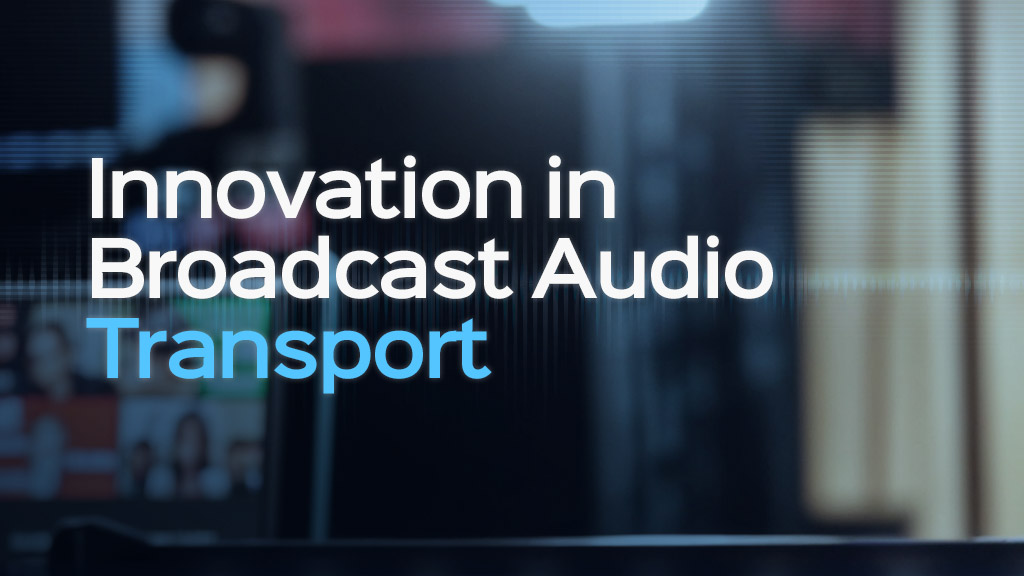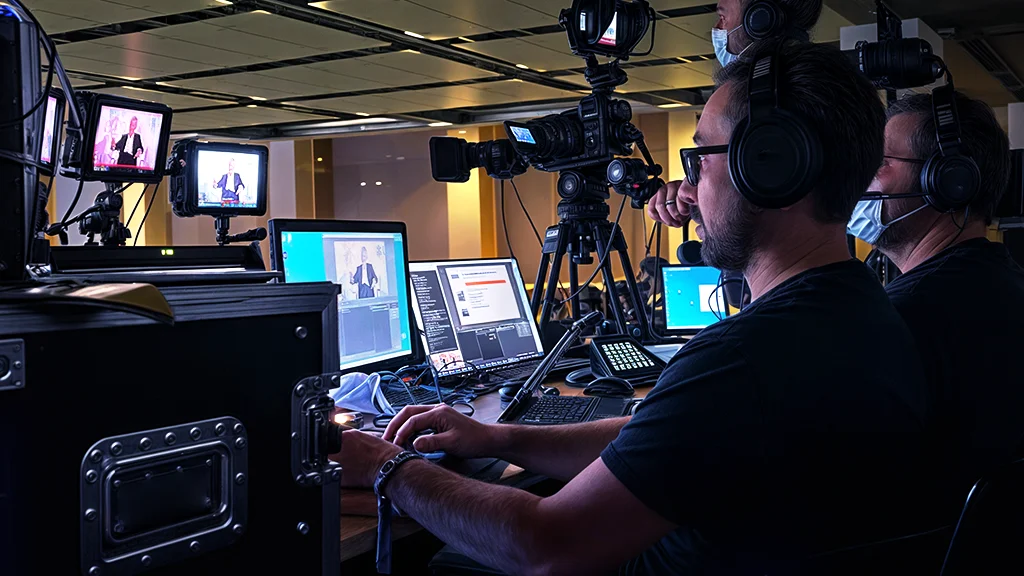
- Article
Audio Transport in Broadcasting: Key Technologies, Protocols, and Innovations
Audio transport in broadcasting refers to the process of transmitting audio signals from one location to another, typically for the purpose of broadcasting or recording. This can involve various methods and technologies, depending on the specific needs and requirements of the broadcast. One common method of audio transport is through traditional analog connections, such as XLR cables or patch bays.
These connections allow for direct physical transmission of audio signals between different devices or locations. Another common approach to audio transport is through digital means, such as using networked audio systems or digital signal processing (DSP) equipment. This allows for more flexible and efficient transmission of audio signals, often over long distances and with higher fidelity.
In broadcasting, it is common to use specialized protocols and standards for audio transport, such as AES/EBU or MADI (Multichannel Audio Digital Interface) and also using standard IP networks, such as Ethernet, to transport audio signals, leveraging protocols. These standards ensure compatibility and interoperability between different radio broadcast equipment and systems.
Overall, the concept of audio transport in broadcasting involves the careful management and transmission of audio signals to ensure high-quality sound reproduction for audiences across various platforms. It requires a deep understanding of both analog and digital technologies, as well as an awareness of industry standards and best practices.
Audio transportation Importance in Broadcasting
Audio transport is a crucial aspect of broadcasting as it directly impacts the quality and delivery of audio content to audiences. Here are some key reasons why audio transportation is important in broadcasting:
Quality Sound Reproduction
Effective audio transport ensures that the original sound captured during recording or production is faithfully reproduced when broadcast to audiences. This includes maintaining fidelity, clarity, and consistency throughout the transmission process.
Reliability and Redundancy
Broadcast operations require highly reliable audio transportation systems to minimize the risk of signal loss or interruption. Redundant audio transport paths and backup systems are often implemented to ensure that the broadcast can continue uninterrupted in the event of a failure.

Scalability and Flexibility
Broadcast operations often involve the integration of multiple audio sources, such as microphones, music, and sound effects, from various locations. Efficient audio transportation solutions enable the seamless integration and routing of these audio inputs, allowing for greater flexibility in production and post-production workflows.
Multi-platform Distribution
With the proliferation of multiple broadcasting platforms such as radio, television, streaming services, and digital media, efficient audio transportation is essential for delivering consistent sound across diverse mediums.
In summary, audio transportation is a fundamental aspect of broadcasting, as it ensures the reliable, high-quality of audio signals, enabling broadcasters to create engaging and immersive experiences for their audiences. Continuous innovation in audio transportation technologies is crucial for the broadcast industry to keep pace with the evolving media landscape and audience expectations.
Evolution of Digital Audio Transport
The evolution of digital audio transport in broadcasting has been a transformative journey, moving the industry from traditional analog systems to more advanced digital solutions. Here’s an overview of the key milestones in this evolution:
Transition from Analog to Digital
Analog audio transport: Historically, broadcast audio was transported using analog technologies, such as balanced audio cables, audio distribution amplifiers, and patch bays.
Digital audio transport: The advent of digital technologies paved the way for the adoption of digital audio transport solutions, which offered several advantages, including:
• Higher audio quality and fidelity
• Improved noise rejection and signal-to-noise ratio
• Easier signal routing and distribution
• Compatibility with emerging digital audio broadcast formats and technologies
Digital Audio Interfaces and Protocols
• AES/EBU: One of the earliest digital audio transport protocols, AES/EBU (Audio Engineering Society/European Broadcasting Union) enabled the transmission of digital audio over balanced cables.
• MADI (Multichannel Audio Digital Interface): Introduced in the late 1980s, MADI allowed for the transport of multiple channels of digital audio over a single cable or fiber optic link, facilitating the transition to multichannel audio in broadcast applications.
• AES67: Developed in 2013, AES67 is a standard that enables audio-over-IP (AoIP) interoperability between different manufacturers’ equipment, promoting a more open and integrated digital audio transport ecosystem.
Audio over IP (AoIP) Technologies
• The rise of IP-based networks and the increasing availability of high-bandwidth connectivity paved the way for the development of broadcast audio over IP technologies.
• Protocols emerged, providing reliable, low-latency solutions for transporting audio signals over standard IP infrastructure.
• AoIP offered greater flexibility, scalability, and cost-effectiveness compared to traditional point-to-point audio cabling, enabling more efficient broadcast workflows.
Cloud-Based Audio Transport
• The advent of cloud computing has enabled the development of cloud-based audio transport solutions.
• These cloud-based platforms allow for the processing, mixing, and distribution of audio signals from remote locations, reducing the need for on-site hardware and enabling more agile, collaborative production workflows.
Wireless Audio Transport
• Advancements in wireless communication technologies, such as 5G and Wi-Fi 6, have facilitated the development of reliable, low-latency wireless audio transport solutions.
• Wireless audio transport enables greater flexibility and mobility in broadcast applications, such as wireless microphones, wireless intercom systems, and wireless camera audio.
Immersive Audio Formats
• The demand for immersive audio experiences, such as surround sound and object-based audio, has driven the evolution of digital audio transport.
• Formats like Dolby Atmos, MPEG-H, and NGA (Next-Generation Audio) require advanced audio transport mechanisms to deliver these enhanced audio experiences to the audience.
The evolution of digital audio transport in broadcasting has been a gradual and ongoing process, with each advancement addressing the changing needs of the industry and the evolving expectations of viewers and listeners. As technology continues to progress, further innovations in audio transport are expected to enhance the quality, flexibility, and efficiency of broadcast audio delivery.

Role of Audio over IP in Modern Broadcasting
Audio Broadcast over IP (AoIP) technology has played a crucial role in the modern broadcasting industry, revolutionizing the way audio content is transported, managed, and distributed. Here are some key roles of AoIP in modern broadcasting:
Flexibility and Scalability: AoIP allows for easy integration and expansion of audio networks, providing broadcasters with the flexibility to adapt to changing production requirements or scale their operations without significant infrastructure changes.
Efficient Transmission: AoIP enables the transmission of high-quality audio broadcast system over standard Ethernet networks, reducing the need for specialized cabling and allowing for more efficient distribution of audio signals within broadcasting facilities.
Interoperability: AoIP protocols such as AES67 and Dante offer interoperability between different manufacturers’ equipment, facilitating seamless integration of various devices from different vendors into a unified audio network.
Remote Production Capabilities: With AoIP, broadcasters can efficiently transport high-quality audio over IP networks, enabling remote production workflows where content can be captured at one location and mixed or processed at another without compromising on sound quality.
Centralized Control and Management: AoIP systems often come with centralized control interfaces that allow broadcasters to manage large-scale audio infrastructures more effectively while providing real-time monitoring capabilities for enhanced operational control.
Enhanced Audio Quality: By leveraging uncompressed or lightly compressed multi-channel digital audio transport protocols over IP networks, broadcasters can ensure higher fidelity transmission compared to traditional analog methods.
Redundancy and Reliability: Many AoIP systems offer built-in redundancy features that provide fail-safe mechanisms for uninterrupted broadcast operations in case of network failures or equipment malfunctions.
Integration with IT Infrastructure: The convergence of broadcast operations with IT infrastructure has been facilitated by AoIP technology, enabling cost-effective use of standardized networking components while leveraging existing network management practices within broadcasting facilities.
Overall, Audio over IP technology has significantly transformed modern broadcasting by providing scalable, efficient, interoperable solutions that enhance flexibility in production workflows while ensuring high-quality transmission and streamlined management capabilities within complex broadcast environments.
Explanation of audio multiplexing and its significance in broadcasting
Audio multiplexing is a method used to combine multiple audio signals into a single composite signal for transmission or distribution. This process allows broadcasters to efficiently utilize available bandwidth, optimize resource allocation, and streamline the management of audio content. This is accomplished by using various multiplexing techniques, such as time-division multiplexing (TDM), frequency-division multiplexing (FDM), or statistical multiplexing.
The multiplexed signal can then be transmitted or stored, and later demultiplexed at the receiving end to recover the individual audio channels.
The significance of audio multiplexing in broadcasting can be understood through the following points:
Improved Bandwidth Utilization: Audio multiplexing allows broadcasters to make more efficient use of available bandwidth by transmitting multiple audio channels simultaneously, instead of allocating separate bandwidth for each individual audio stream.
Support for Multichannel Audio: Multiplexing enables the transport of multichannel audio formats, such as surround sound, Dolby Atmos, or MPEG-H, which are becoming increasingly important for providing immersive audio experiences to viewers and listeners.
Flexibility in Audio Routing and Distribution: Multiplexed audio signals can be easily routed, switched, and distributed throughout the live broadcast infrastructure , facilitating complex audio workflows and enabling more efficient production and post-production processes.
Cost Savings: By reducing the number of physical audio transport channels required, audio multiplexing can lead to cost savings in terms of cabling, infrastructure, and equipment necessary for broadcast operations.
Improved Reliability and Redundancy: Multiplexed audio signals can be designed with built-in redundancy, ensuring that the loss or disruption of a single audio channel does not result in a complete audio failure, thus improving the overall reliability of the broadcast system.
Examples of Audio Multiplexing in Broadcasting
Digital Audio Transport Protocols: Standards like AES10 (MADI) and AES67 enable the multiplexing of multiple audio channels over a single digital transport link, simplifying audio routing and distribution.
Embedded Audio in Video Signals: Broadcast video formats, such as SDI (Serial Digital Interface) and SMPTE ST 2110, often include the ability to embed multiple audio channels within the video stream, allowing for the synchronized transport of audio and video. SAE-3390 audio embedder is a compelling and flexible solution for embedding eight audio pairs to a 3G/HD/SD-SDI signal from analog/digital audio inputs.
Audio multiplexing plays a vital role in modern broadcasting by enabling more efficient use of available bandwidth, supporting advanced audio formats, and enhancing the overall flexibility and reliability of broadcast audio systems. As the demand for immersive audio experiences and the complexity of broadcast workflows continue to grow, the importance of audio multiplexing in the broadcasting industry is likely to increase further.









